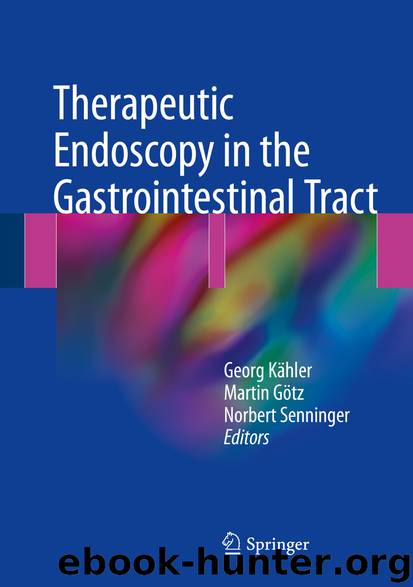Therapeutic Endoscopy in the Gastrointestinal Tract by Georg Kähler Martin Götz & Norbert Senninger

Author:Georg Kähler, Martin Götz & Norbert Senninger
Language: eng
Format: epub
Publisher: Springer International Publishing, Cham
In contrast, celiac plexus neurolysis (EUS-CPN) causes permanent and irreversible nerve damage and thus toxically destroys most tissues that are hit by the injection jet during CPN. For this purpose, a pure 98% ethanol solution – combined with a common local anesthetic – has been used in most instances.
To avoid toxic hazards during EUS-CPN, both operator and assistant(s) are required to wear fluid-resistant coats and face masks during the operation to protect against toxic splashes, eye contacts, and other harmful collateral effects. For the performance of EUS-CPN, different injection needles have been used ranging from small-caliber 25-G needles over 22-G FNA needles up to 19-G therapeutic FNA needles, while one dedicated injection needle with multiple side holes is still commercially available (companies: MediGlobe, Cook, Boston Scientific, MTW, Olympus, Covidien, and others). Up to now, no clinical study exists that clearly demonstrates distinct differences in terms of the therapeutic yield of the dedicated injection needle that would justify its very high price. Personally, we recommend use of 19- or 20-gauge FNA needles for EUS-CPN, since the wide lumen offers some advantages for the technical performance of injections – even in relatively rigid tissues. This approach should also – at least theoretically – reduce the risk of toxic splashing under such therapeutic conditions.
For EUS-CPN, a dedicated linear sideways-looking or forward-looking echoendoscope is to be used that allows for direct visualization of the root of the celiac plexus and also depicts some of the plexus ganglia in many cases (see paragraph below). The celiac plexus originates ventrally and cephalad of the proximal abdominal aorta, while the celiac plexus and its surrounding ganglion network is largely located in direct anatomical proximity of such visible nerve ganglionic nodules. The smaller nerve fibers and networks, however, cannot be visualized by EUS which limits the technique to some visible – and many suspected but invisible – structures in this clinical setting (see cartoon/image in ◘ Fig. 5.13a). The basic materials and instruments for the performance of EUS-CPN are demonstrated by ◘ Fig. 5.13b.
Fig. 5.13 a Anatomical position (sketch drawing) of the celiac plexus. b Additional materials for the EUS-guided plexus neurolysis of the celiac plexus, also referred to as «EUS-guided celiac injection therapy» (EUS-FNI)
Download
This site does not store any files on its server. We only index and link to content provided by other sites. Please contact the content providers to delete copyright contents if any and email us, we'll remove relevant links or contents immediately.
| Anesthesiology | Colon & Rectal |
| General Surgery | Laparoscopic & Robotic |
| Neurosurgery | Ophthalmology |
| Oral & Maxillofacial | Orthopedics |
| Otolaryngology | Plastic |
| Thoracic & Vascular | Transplants |
| Trauma |
When Breath Becomes Air by Paul Kalanithi(7289)
Why We Sleep: Unlocking the Power of Sleep and Dreams by Matthew Walker(5677)
Paper Towns by Green John(4188)
The Immortal Life of Henrietta Lacks by Rebecca Skloot(3840)
The Sports Rules Book by Human Kinetics(3611)
Dynamic Alignment Through Imagery by Eric Franklin(3510)
ACSM's Complete Guide to Fitness & Health by ACSM(3481)
Kaplan MCAT Organic Chemistry Review: Created for MCAT 2015 (Kaplan Test Prep) by Kaplan(3435)
Introduction to Kinesiology by Shirl J. Hoffman(3315)
Livewired by David Eagleman(3151)
The River of Consciousness by Oliver Sacks(3007)
Alchemy and Alchemists by C. J. S. Thompson(2922)
The Death of the Heart by Elizabeth Bowen(2920)
Descartes' Error by Antonio Damasio(2756)
Bad Pharma by Ben Goldacre(2741)
The Gene: An Intimate History by Siddhartha Mukherjee(2508)
Kaplan MCAT Behavioral Sciences Review: Created for MCAT 2015 (Kaplan Test Prep) by Kaplan(2500)
The Fate of Rome: Climate, Disease, and the End of an Empire (The Princeton History of the Ancient World) by Kyle Harper(2450)
The Emperor of All Maladies: A Biography of Cancer by Siddhartha Mukherjee(2445)
